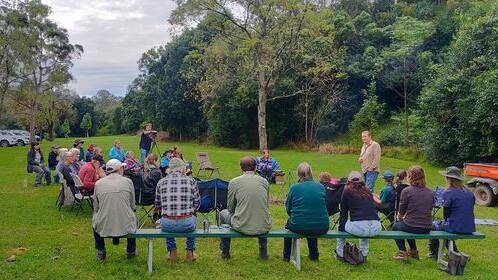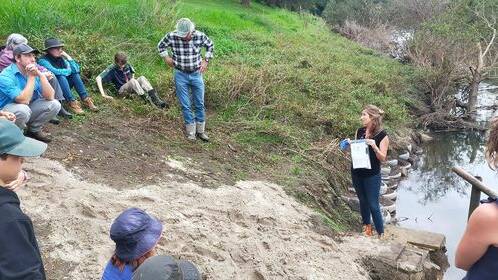
DNA is being used to determine the diversity of animals and the health of creeks and rivers in the Manning region.
Subscribe now for unlimited access.
or signup to continue reading
Local schools and community organisations are involved in the project which is being coordinated by the Manning River Turtle Group, auspiced under Manning Valley Neighbourhood Services.
Representatives from 10 schools and organisations recently gathered at Knorrit Flat Riverside Retreat on the banks of the Nowendoc River.
The workshop involved demonstration of techniques that can identify the range of animals in the environment by sampling the water of a creek, river or wetland.
Animals are always shedding material into the environment from their hair, skin, body secretions and excrement. By taking water samples and filtering out this microscopic material, researchers can identify different animals by their unique DNA.
Dr Elise Furlan from the University of Canberra is a lead researcher in environmental DNA or eDNA. Elise compared the technique to crime scene forensics.
Charles Sturt University is also a project partner and Dr Jess Tout-Lyon provided a hands-on demonstration of the sampling technique to the eager audience.
Participants range in age from primary school students to retirees and include representatives from Landcare, Scouts, Land for Wildlife, U3A, Environment Groups, OzFish and TIDE Aboriginal rangers.

Key themes in the workshop were learning and story-telling. Participants were encouraged to learn the stories of the land through scientific investigation and to tell stories to share their knowledge.
"The workshop was fantastic. We all benefitted from the knowledge of expert university researchers and are keen to now go and investigate our favourite local waterways," Clare Rourke from the Manning River Turtle Group said.
Each participating organisation has been given a sampling pack and will now go and sample the waters of a local freshwater creek or river of their interest. The samples will be analysed and the results of all the investigations will be shared via an online webinar to be held during National Science Week (August 13-21).
Sampling is being undertaken in the Manning and Lansdowne rivers and Dingo, Burrell and Killabakh creeks.

At Gloucester, samples are being taken from the Gloucester, Avon and Bowman Rivers.
Alisha Madsen from MidCoast Council said many participants are keen to identify iconic species such as the platypus, Manning River turtle and Australian Bass in their local waterways. "There is a lot of excitement about what species we will detect."
The project is supported with funding from a National Science Week grant from the Australian Government.
WHILE YOU'RE WITH US:
Our journalists work hard to provide local, up-to-date news to the community. This is how you can continue to access our trusted content:
- Bookmark our website
- Make sure you are signed up for our breaking and regular headlines newsletters
- Follow us on Twitter
- Follow us on Instagram: @manningrivertimes
- Follow us on Google News
Did you know? https://www.manningrivertimes.com.au/subscribe/ not only have 24/7 access to local and national news, sport, what's on and entertainment - they also have access to our print edition in digital format, with all the advertisements and classifieds at their fingertips.

